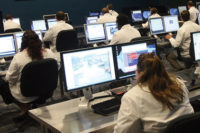
The Visual Management Systems in-house customer service team at work.

GoVye, a series of system management services, gives VMS customers the opportunity to use the Internet to access information, service or support related to VMS products.
Traditional customer service avenues such as a toll-free tech support hotline and an attentive customer service department are part of VMS’s customer service package, but it is the company’s use of technology to offer live, remote assistance as well as training, software upgrades and installation in real time that makes its service shine. Real time enhances responsiveness, and as Gonzalez points out, “One of the major reasons we’re successful is we understand that the most effective video surveillance solutions demand personalized, responsive customer service.”
From the very beginning, VMS realized that customer service was going to be a central facet of its business model, but the key was finding a way to make it as quick and responsive as possible.
“Given the critical role our product plays in the operation of many companies, we knew we needed a way to immediately respond to a client’s problem. If a camera goes out, or if the client needs help sharing information with law enforcement, each passing moment can make a difference,” Gonzalez says. So in addition to the traditional customer service department, VMS turned to technology to employ even quicker service.
GotoAssist, a technical support help desk that uses Citrix-based technology to offer real-time live support through a remote management platform, is one of the results.
GotoAssist allows VMS to remotely access its client’s DVRs, enabling technicians to see what the client is seeing, perform system diagnostics and troubleshoot any issues. GotoAssist can also be used to train clients remotely. “On-site training is the norm,” Gonzalez says. “However, if a key employee is unable to attend training, or if personnel change, we can conduct remote training sessions as needed. With GotoAssist, we have the ability to demonstrate features and functions of the DVR as clients’ watch on their local monitor.”
It could be argued that the most beneficial aspect of the system is its ability to provide instantaneous service.
“Clients love the system because they know that if they need immediate assistance, we can access their system on a moment’s notice without dispatching a technician,” Gonzalez says. “Essentially, GotoAssist allows us to have virtual on-site access as soon as a problem is encountered. It is like having a high-end service technician on call and, even better, on site,” Gonzalez points out.
According to Gonzalez, connectivity and diagnostic software, in the hands of a skilled technician, is the most immediate and cost-effective way to respond to most issues or questions a client may encounter with a technology-based solution.
“As software becomes the principal tool of business, and the Internet becomes the principal medium of communication, companies need to appreciate that the most effective way to provide service to their clients is through these channels. It used to be said that it was ideal to have a technician on-site in order to resolve an issue, and, in the absence of that, remote diagnostic tools were a distant second-best alternative. That is no longer the case. Today, many problems can be diagnosed and solved remotely with less overhead and stress for the vendor, and, more significantly, for the client. For those scenarios that still require hands-on interaction, we’re finding that a combination of remote diagnostic and connectivity software along with the deployment of a technician on site is optimal.”
When an issue cannot be resolved electronically, the company has a fleet of service vehicles and staff technicians ready to be dispatched. But currently, 70 percent of the company’s service issues are resolved online — without ever leaving the help desk. That’s a number that is hard to ignore.
The company also spent several years developing GoVye, a series of system management services that maximize clients’ investment in their surveillance infrastructure. The latest version introduced the GoVye Portal.
The GoVye Portal includes a health monitor, which relays information on system performance to technicians and alerts them in the case that any portion of the infrastructure needs maintenance or repair; a secret shopper program, where VMS personnel act as “virtual managers” — looking in on an organization’s operations and reporting back to the client on highlighted aspects of its business; a maintenance and service scheduling tool; and upgrades and promotions available only to clients.
The GoVye Portal may be accessed through any Internet connection, including the client’s video server.
Because the suite of services covers everything from system health checks to services that used to be considered “brick and mortar”-type services and brings them into cyberspace, VMS can provide the service for much less than if a company had to go out and hire real people, and can often schedule service calls before the customer even knows there is a problem.
“As reflected by the development of the GoVye service line and platform, we are always looking for new ways to enhance customer service and increase responsiveness,” Gonzalez says. “And by allowing our service to be tied to be a living, breathing, very dynamic set of tools, we can continually adapt to what our customers want and need."


